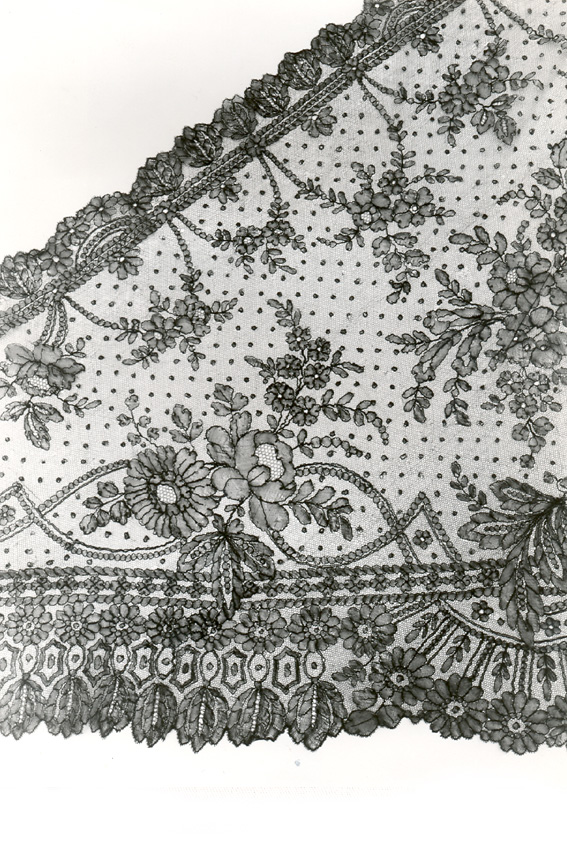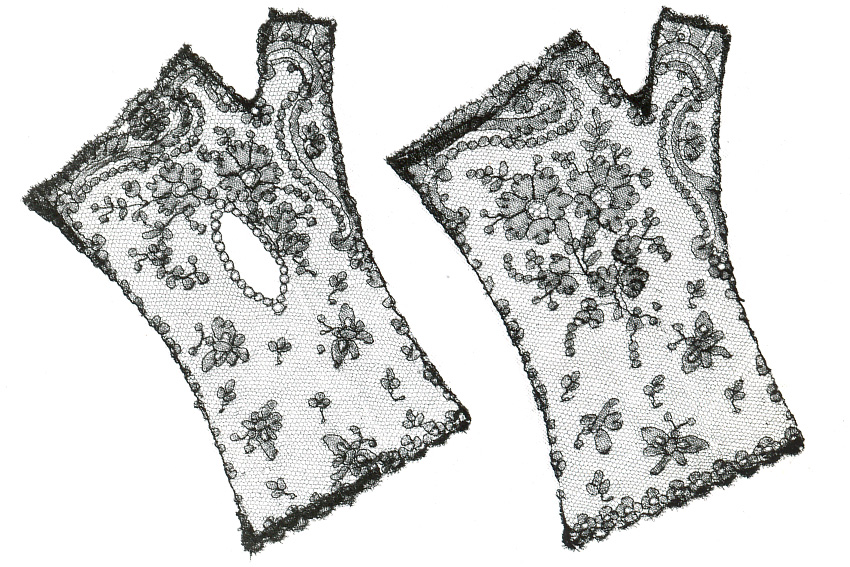Chantilly Lace on:
[Wikipedia]
[Google]
[Amazon]


 Chantilly lace is a handmade
Chantilly lace is a handmade
Chantilly lace – Virtual Museum of Textile Arts
{{Lace types Bobbin lace History of clothing (Western fashion) Textile arts of France


 Chantilly lace is a handmade
Chantilly lace is a handmade bobbin lace
Bobbin lace is a lace textile made by braiding and twisting lengths of thread, which are wound on bobbins to manage them. As the work progresses, the weaving is held in place with pins set in a lace pillow, the placement of the pins usually de ...
named after the city of Chantilly,"Chantilly" ''The Oxford English Dictionary''. 2nd ed. 1989. France, in a tradition dating from the 17th century. The famous silk laces were introduced in the 18th century. ''Chantilly lace'', was also produced in the 19th century but this one was actually made not in Chantilly area but in the French Norman town Bayeux
Bayeux () is a Communes of France, commune in the Calvados (department), Calvados Departments of France, department in Normandy (administrative region), Normandy in northwestern France.
Bayeux is the home of the Bayeux Tapestry, which depicts ...
and in Geraardsbergen, now in Belgium.
Chantilly lace is known for its fine ground
Ground may refer to:
Geology
* Land, the surface of the Earth not covered by water
* Soil, a mixture of clay, sand and organic matter present on the surface of the Earth
Electricity
* Ground (electricity), the reference point in an electrical c ...
, outlined pattern, and abundant detail. The pattern is outlined in ''cordonnet'', a flat untwisted strand. The best Chantilly laces were made of silk, and were generally black, which made them suitable for mourning wear. White Chantilly lace was also made, both in linen and silk, though most Chantilly laces were made of silk. The black silk Chantilly lace became especially popular, and there was a large market for it in Spain and the Americas. Chantilly and the Spanish laces (such as blonde lace) were the most popular black laces. Little white Chantilly was ever made. Another notable thing about Chantilly lace is the use of a half-and-whole stitch as a fill to achieve the effect of light and shadow in the pattern, which was generally of flowers. The background, or ''réseau'', was in the form of a six pointed star, and was made of the same thread as the pattern, unlike the otherwise similar blonde lace. The lace was produced in strips approximately four inches wide, and then joined with a stitch that left no visible seam.
Chantilly lace remained popular in 19th century Europe, when many fashionable women wore black or white Chantilly shawls made in Brussels or Ghent.
History
In the 17th century, theDuchesse de Longueville
Duchesse (Duchesse satin) was a soft, heavy, and glossy satin cloth made in France.
Weave
Duchesse was produced with a satin weave with fine silk threads using a higher number of threads per square inch in the warp with at least seven floati ...
organised the manufacture of lace at Chantilly. It has been produced from then until the present day. It became popular because of the duchesse's patronage and Chantilly's proximity to Paris and came into fashion again during the reigns of Louis XV and Louis XVI; it was a special favorite of Louis XV's last mistress, Mme du Barry, and of Marie Antoinette
Marie Antoinette Josèphe Jeanne (; ; née Maria Antonia Josepha Johanna; 2 November 1755 – 16 October 1793) was the last queen of France before the French Revolution. She was born an archduchess of Austria, and was the penultimate child a ...
. When the French Revolution began in 1789, demand for the lace ceased. The lace-makers were seen as protégés of the royals, and after Mme du Barry and Marie Antoinette were guillotined in 1793, the lace-makers of Chantilly were themselves killed. At this point production ceased.
Napoleon I
Napoleon Bonaparte ; it, Napoleone Bonaparte, ; co, Napulione Buonaparte. (born Napoleone Buonaparte; 15 August 1769 – 5 May 1821), later known by his regnal name Napoleon I, was a French military commander and political leader who ...
sponsored a revival of Chantilly lace between the years 1804 and 1815. At this point production was concentrated in Normandy, mainly around the Bayeux area. While it was no longer being made in Chantilly, all of the old techniques and designs were used. Chantilly lace reached the height of its popularity around 1830 and was revived again in the 1860s, at which point it was made at Bayeux as well as at Geraardsbergen, in what is nowadays Belgium.
In 1844, a machine was patented that made Valenciennes lace and black silk Chantilly lace that was difficult to distinguish from the handmade lace.
References
External links
Chantilly lace – Virtual Museum of Textile Arts
{{Lace types Bobbin lace History of clothing (Western fashion) Textile arts of France